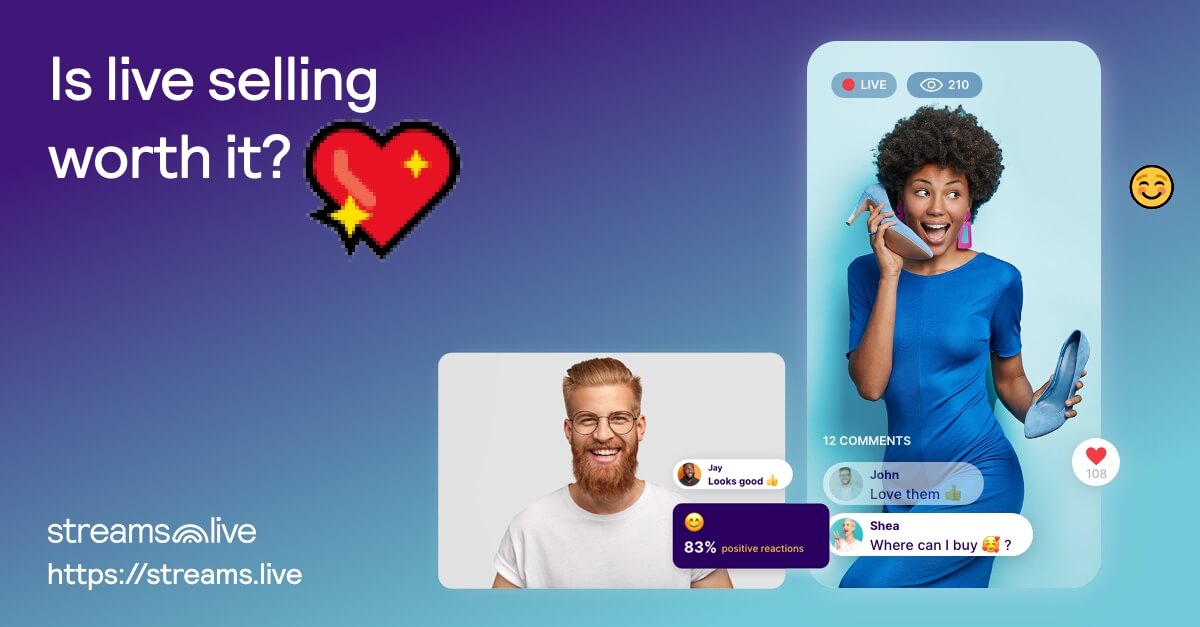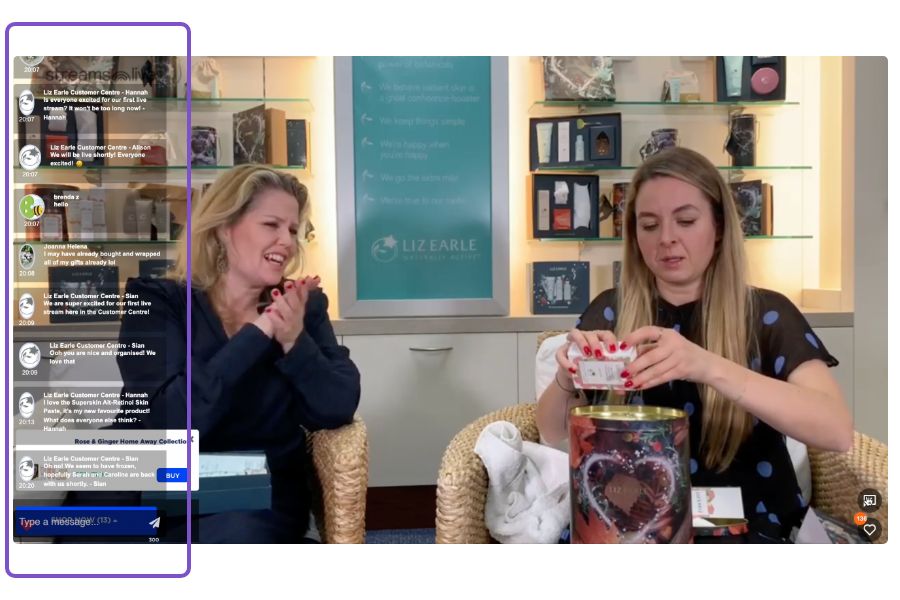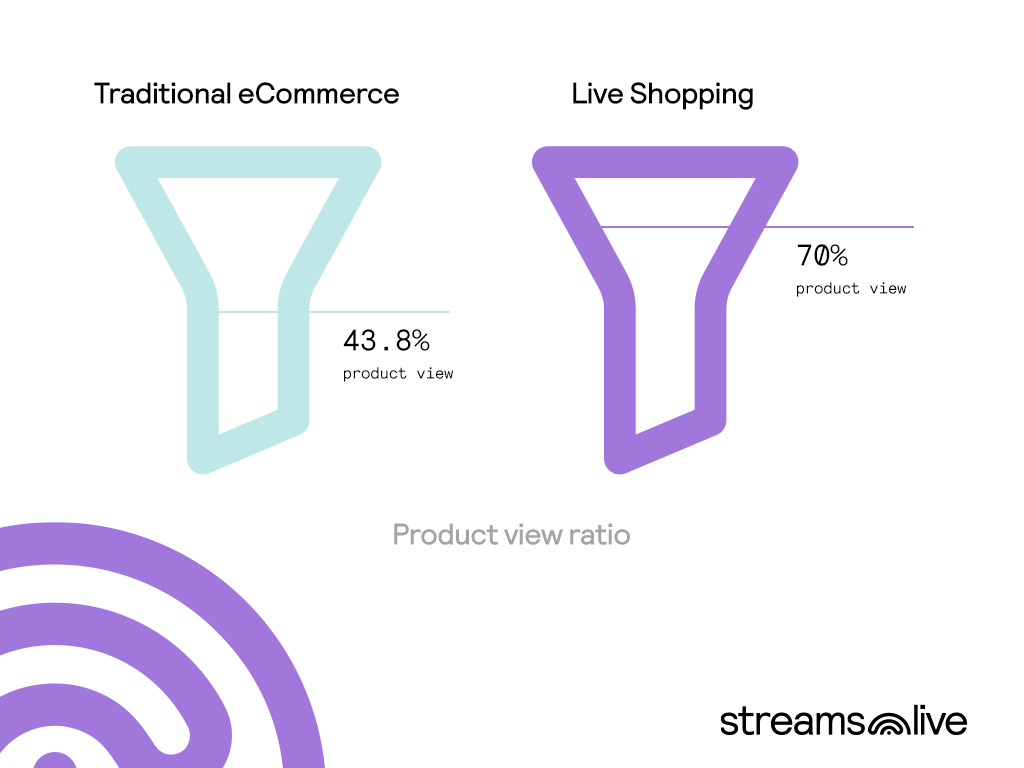
What is live selling?
Live selling is the practice of selling products through live video streaming. It has become extremely popular as live shopping (or live commerce) as it transforms the customer journey into an engaging experience. And in this article, we’ll see if it’s worth it for brands to adopt live selling as part of their strategy.
The experience is part entertainment, part video streaming, and part eCommerce. It brings the in-store shopping experience into your customers’ homes. The result? Businesses from all over the world are creating live shopping events. From cosmetics and fashion to home goods and consumer electronics, brands are using it to reach new customers, boost sales, and create and increase brand loyalty.
In this article, we will look at live selling, in general, to see if it’s worth it. We’ll pinpoint the benefits, but also see which could be the drawbacks. However, as we will further see, the drawbacks can be easily solved with just a little planning.
The past and future of live selling
This new type of eCommerce originated in China and has rapidly made its way into the western eCommerce markets. Back in 2016, Alibaba launched its live shopping platform, Taobao. Almost simultaneously, Amazon took its first “swing” at live shopping through the giant’s first iteration: Style Code Live. While in the Chinese eCommerce market, live shopping was an (almost) instant hit, the adoption was a little bit slower in the west. But fast forward to 2023, and we can say that this new way of shopping has reshaped the eCommerce market. And here are the numbers to prove it:
As for last year, live selling experiences hit $20 billion in revenue. What is even more encouraging is the estimated growth of this trend. It’s estimated that by 2025 it will see an almost 3X increase, reaching $57 billion.
In the Chinese eCommerce market, the numbers are mindblowing. According to Statista, by the end of 2023, the live shopping market will reach 4.9 Trillion yuan. More than $700 billion will come from eCommerce transactions that occurred in live shopping sessions.
Main benefits of Live Selling
Why is live selling revolutionizing eCommerce at scale? Because of its liveliness, it brings the in-store shopping experience into a digital environment. From the comfort of their homes, customers watch live product presentations, interact with the live selling event host or fellow customers, and buy with a single click of a button. Now, let’s take a deeper look at these benefits.
Ability to showcase products in a dynamic and authentic way
Live selling experiences allow brands to showcase their products through live video. This results in a very dynamic and authentic experience, one that helps your customers get a better understanding of your products. During traditional eCommerce experiences, shoppers interact with photos and text, and maybe short product videos. And this type of content doesn’t always offer all the answers customers need. And this stops customers from buying.
A live selling experience helps your customers get a better sense of your products. This dynamic showcase answers many of the questions that would otherwise remain answered. They see how the products perform. And they see it from multiple angles. And the authenticity of a live video presentation assures them that there isn’t any photoshop or video editing involved.
Live selling increases customer engagement
According to Facebook, people spend 3x more time on live video than with any other form of content. As the closest thing to in-person interactions, live video experiences capture our attention. And this means more than just time spent on site. It means more time customers allocate to understand how a product looks and feels. It’s easier for you to demonstrate your expertise and passion for your industry, and foster a sense of community and connection with your customers.
By creating a dynamic and engaging shopping environment, live selling helps you capture the attention and loyalty of customers, and drive conversions and repeat purchases.
Create real-time interaction and feedback opportunities

As previously mentioned, one of the biggest bottlenecks eCommerce faces is that customers can’t get answers in real-time. According to Salesforce, 80% of customers have at least one question they need to find answers to before purchasing a product or service online. And live selling solves this issue exactly when it matters the most.
This real-time experience gives your audience a chance to interact with a shopping assistant. And now, they can do it from the comfort of their homes, while they watch live product presentations. This gives you valuable insights into their pain points, needs, and preferences. And this will help you with your future product development and marketing efforts. Furthermore, live selling allows you to test and refine your sales pitch, respond to objections, and make real-time adjustments to your strategy based on customer feedback.
Drawbacks of Live Selling
Although it provides excellent conversion rates, there are many myths surrounding the field of live shopping. And this stops eCommerce professionals from implementing live shopping into their marketing in sales efforts.
Further down the road, let’s tackle these potential problems and see how to overcome them.
Are there any technical challenges and limitations?
The spread of live selling is fueled by the outstanding technological evolutions that we have seen over the last few years. Imagine what you needed five years ago to deliver an outstanding live video experience. The mix of hardware and software and, of course, the total cost involved in deploying such an experience online. Today, all you need is a decent smartphone and a stable internet connection.
There are many ways to deliver a live selling experience, each with its pros and cons. There are multiple platforms where you can sell live – to a certain extent. Where you decide to sell on a marketplace like Amazon, use a social media platform like Facebook or Instagram, or take total control over the experience with the help of a dedicated live shopping platform like Streams.live, you have all the strings to go live, engage your audience, and sell.
Preparation and planning a live selling experience
Live shopping events don’t just happen. They need some preparation to obtain exceptional results. But you’ll be happy to learn that, at a minimum, there are just 4 things you need to reach these results, and you already have them. These things are:
- A product or service that you want to sell online
- A live shopping platform to sell them on (+ a phone or to go live from)
- Someone to go in front of the camera to showcase the products and discuss with your audience
- Someone to sell to (an audience)
Once you decide that live selling is worth it, this checklist will help stay on track and deliver better eCommerce experiences. And further down the line, when you start promoting your event, you can check out this article on how to reach broader audiences.
Comparison with traditional sales channels
When it comes to conversion rates, live selling has no worthy rival. With an average conversion rate of 9%, live shopping is the best online selling channel. All due to the incredible shopping experience that it enables.

Live selling finds itself at the sweet spot between in-store and digital shopping. Customers can interact with shop assistants without having to go to the store. It empowers brands to create assisted shopping experiences in the digital environment, keeping all the benefits from both experiences. At the same time, live shopping gathers and improves the top 5 elements that make a traditional product page convert.
Demographic analysis of live selling audiences
By selling through live video experiences, brands have the chance to reach new, broader audiences. According to a survey conducted by Wunderman Thompson Commerce, most live shopping viewers are between the ages of 26 and 45. For Gen Zs and Millennials, the shopping experience itself is as valuable as the products they are buying. But they are not the only ones that are looking to buy products from a live interactive video session, as this experience helps all customers get more information about the products they are about to purchase.
A study conducted by Statista revealed that more than 3 quarter of Chinese online shoppers (77%) used a live shopping experience to buy products. In the Us, although the adoption rate is for the moment slower, the numbers are extremely interesting. Almost half of the interviewed shoppers (44%) used this type of experience to purchase something
Final thoughts
Hopefully, this article helped you understand why live selling is worth it. As we have identified in this article, live selling provides an improved customer experience. It helps buyers watch live product demonstrations, where they can interact with the host, ask questions, and instantly get the answers they are looking for.
The authenticity provided by live video nurtures a better connection between you and your audience. All while allowing customers to buy with a simple click of a button, thus creating a seamless shopping experience.
Live selling provides the needed tools to digitally recreate the in-store shopping experience. It helps brands assist customers during their shopping journey, offering benefits similar to in-store shopping experiences. But all from the comfort of their homes.
And while there are many myths surrounding this experience, getting started with live selling is extremely easy. All you need is a live selling platform (and we are here to help you), a product or service to sell, a host for the session, and an audience to sell to. So if you’re ready to start selling live but need our support just drop us a line and we will gladly help you out.





